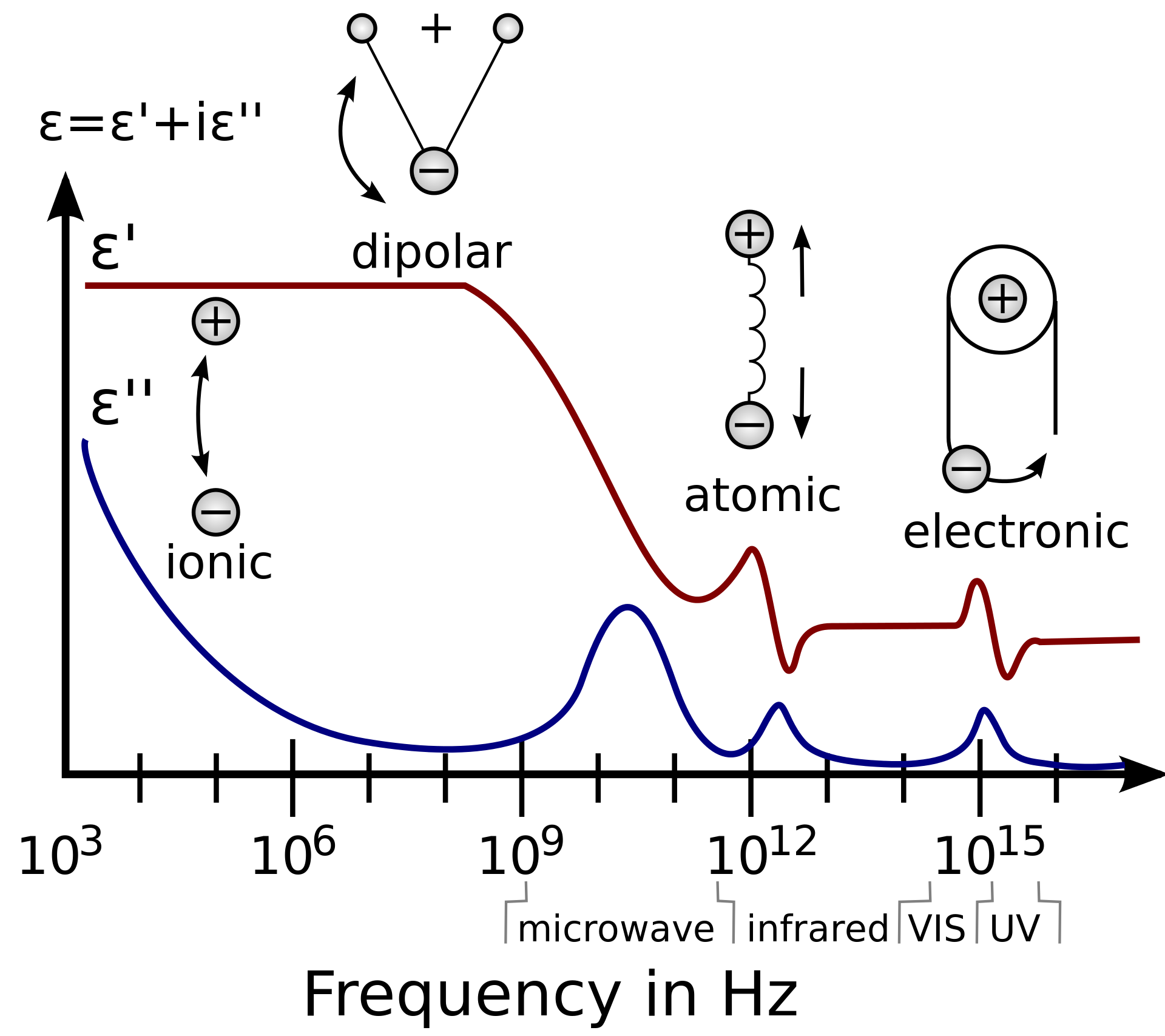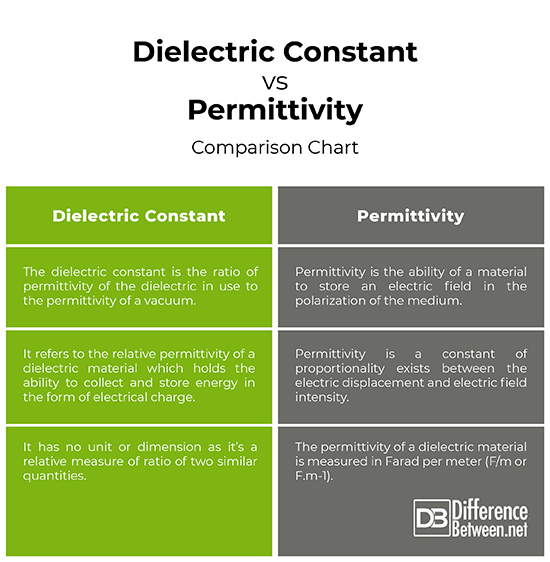Difference Between Dielectric Constant and Permittivity
The study of dielectrics and their behavior in electric fields continue to fascinate physicists and electrical engineers alike. Despite the fact that dielectrics are poor conductors of electricity, they play a fundamental role in electronic circuits, which need a dielectric medium to build the circuit. A basic understanding of dielectrics and their properties is thus required. A dielectric material is nothing but an insulator with a poor conductor of electricity meaning they do not allow current to flow. They are the exact opposite of conductors. Like any other material, a dielectric is an assembly of ions with positive and negative charges. The most important property of dielectrics is their permittivity along with dielectric constant.
The insulating medium separating charged surfaces is called a dielectric. Before we jump into the concept of permittivity, it is important to understand a closely related property, capacitance. Capacitance is the ability of a system to collect and store electrical charge. That being said, the dielectric constant is a measure of the ability of a material to store electrical energy and is defined as the ratio of the capacitance (or permittivity) of the dielectric material to the capacitance of a vacuum. Therefore, all the capacitance values are related to the permittivity of vacuum. Each different dielectric material has its own value of permittivity.
What is Dielectric Constant?
The dielectric constant is the ratio of permittivity of the dielectric in use to the permittivity of a vacuum. It refers to the relative permittivity of a dielectric material which holds the ability to collect and store energy in the form of electrical charge. The relative dielectric constant is a measure of the amount of energy stored in a dielectric insulator per unit electric field. For any material, whether it’s a polymer, ceramic, or a metal, an applied electric field induces an electric polarization within the material. Generally, the magnitude of this polarization is linearly proportional to the applied field. The proportionally constant is called the permittivity, which is often called the dielectric constant. Since the dielectric constant is a relative measure of ratio of two similar quantities, it has no unit or dimension; it is simply represented by numbers. All materials have a dielectric constant greater than 1.
What is Permittivity?
Permittivity is the ability of a material to store an electric field in the polarization of the medium. Usually, the permittivity is expressed as the relative permittivity, which is defined as the ratio of the material permittivity to the permittivity of a vacuum. Air approximates to a perfect vacuum and so the dielectric constant for air is approximately zero. The behavior of molecules in an electric field is characterized by permittivity, which is a very important value that characterizes the influence of any electric field on the behavior of molecules. In engineering applications, permittivity is often expressed in relative. If ε0 represents permittivity of free space and ε represents permittivity, then permittivity εr is expresseds as, εr = ε/ ε0.
Difference between Dielectric Constant and Permittivity
-
Definition of Dielectric Constant and Permittivity
– The dielectric constant is the ratio of permittivity of the dielectric in use to the permittivity of a vacuum. It refers to the relative permittivity of a dielectric material which holds the ability to collect and store energy in the form of electrical charge. Permittivity, on the other hand, is the ability of a material to store an electric field in the polarization of the medium. Usually, the permittivity is expressed as the relative permittivity, which is defined as the ratio of the material permittivity to the permittivity of a vacuum.
-
Unit of Dielectric Constant and Permittivity
– Since the dielectric constant is a relative measure of ratio of two similar quantities, it has no unit or dimension; it is simply represented by numbers. All materials have a dielectric constant greater than 1. Air approximates to a perfect vacuum and so the dielectric constant for air is approximately zero. The most important property of a dielectric material is its permittivity. The permittivity of a dielectric material is symbolized as ε which is related to the permittivity of vacuum. The permittivity of a dielectric material is measured in Farad per meter (F/m or F.m-1). The permittivity of vacuum, sometimes called the electric constant is 8.85×10-12 F/m.
Dielectric Constant vs. Permittivity: Comparison Chart
Summary of Dielectric Constant verses Permittivity
In a nutshell, the dielectric constant is a measure of the ability of a material to store electrical energy and is defined as the ratio of the capacitance (or permittivity) of the dielectric material to the capacitance of a vacuum. Since dielectric constant is relative, it has no unit or dimension. Permittivity is usually expressed as relative permittivity, which is the ratio of the permittivity of the material to the permittivity of a vacuum and is expressed as, εr = ε/ ε0. In engineering applications, permittivity is often expressed in relative. The permittivity of a vacuum is a physical constant which equals to 8.85×10-12 F/m.
- Difference Between Caucus and Primary - June 18, 2024
- Difference Between PPO and POS - May 30, 2024
- Difference Between RFID and NFC - May 28, 2024
Search DifferenceBetween.net :
1 Comment
Leave a Response
References :
[0]Image credit: https://en.wikipedia.org/wiki/Permittivity#/media/File:Dielectric_responses.svg
[1]Image credit: https://passive-components.eu/wp-content/uploads/2017/11/Dielectric_Constant_01.png
[2]Kutz, Myer. Handbook of Materials Selection. Hoboken, New Jersey: John Wiley & Sons, 2002. Print
[3]Davis, Donnette. Studying the Sciences, Physics – Grades 10-12. Morrisville, North Carolina: Lulu Press, n.d. Print
[4]Kaiser, Cletus J. The Capacitor Handbook. Berlin, Germany: Springer, 2012. Print
[5]Blackwell, Glenn R. The Electronic Packaging Handbook. Boca Raton, Florida: CRC Press, 2017. Print




All materials have a dielectric constant greater than 1. Air approximates to a perfect vacuum and so the dielectric constant for air is approximately zero.
I think this should read:
All materials have a dielectric constant greater than 1. Air approximates to a perfect vacuum and so the dielectric constant for air is approximately one.